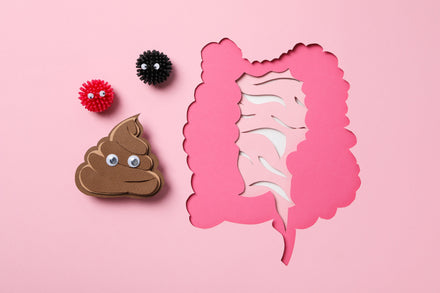If you’re not glancing into the toilet before you flush, you should be.
We’re not kidding. Your bowel movements (aka BMs, aka poops) are a clear window into your health. We’re talking about everything from dietary deficiencies to intestinal conditions: Your stool can be solid evidence of where your body is and what it needs. Pun very much intended.
We’re about to tell you what it all means: color, shape, size, frequency, you name it. So get ready to get the skinny on your stool. The particulars on your poo. The—alright, we’ll quit while we’re ahead. Or behind. (Last one, we promise.)
Let’s Talk Frequency
How often should I be pooping? is a super common question. The answer, as eye-roll inducing as this may be, is as often as your body needs to.
“There’s not really a fixed or normal number of bowel movements,” said Dr. Folasade May, a gastroenterologist, in an interview with CNN.
Contrary to popular belief, the normal time to pop a squat is a pretty wide range: between three times a day and three times a week. Anything outside of those numbers (in either direction) is considered extreme, and might be cause to visit a primary care physician or gastroenterologist.
It’s also important to observe what your normal looks like. Individual patterns are key here. So, if you’re used to pooping twice a week and suddenly find yourself on the toilet twice a day—then yes, it might be time to think about if you’ve had any changes to your routine lately.
Let’s Talk Size
According to medical experts, the normal range for a healthy stool is between 4 to 8 inches long. If your poo is consistently outside of this range, that may be something to look into—and here’s why:
When your poops are too big
Anyone that wants to pretend they haven’t dropped a big one is kidding themselves. But if the majority of your bowel movements are really long or well above eight inches, experts say that could indicate constipation, fecal impaction, or IBS (inflammatory bowel syndrome).
When your poops are too small
If you’re consistently releasing pebble-shaped, narrow, or tiny stools, this potentially could indicate a low-fiber diet, gut infection, or conditions ranging from IBS to some cancers. Another common cause of thin and short stools can also be prescribed medication. But if you are concerned about your fiber intake, introducing a daily prebiotic can be helpful.
Let’s Talk Shape
Lucky us: there’s a handy-dandy chart for this one. In 1997, Dr. Kenneth Heaton and Stephen Lewis developed the Bristol Stool Scale, a diagnostic tool that’s still used to this day to evaluate the shape, length, and texture of poops.
The scale sorts stools into seven types, and each one says something different about your health. We’ve done you the solid of summarizing—without the fun pictures.
Type 1
What it is: Pebbly stools, broken into separate hard lumps. Think those lil’ turtle poops.
What it means: If you’re regularly passing Type 1 stools, you’re likely constipated.
How to fix it: Consult your primary care physician before attempting any home remedies, but they may suggest a stool softener or over-the-counter constipation medication.
Type 2
What it is: Log or sausage-shaped, but very lumpy.
What it means: While not as extreme as Type 1, you’re likely experiencing constipation.
How to fix it: To find some relief, try introducing soluble fiber into your diet. Soluble fiber dissolves in water and forms a “gel-like substance” in your stomach, which will allow your stools to pass more smoothly. Some examples? Chia or flax seeds, legumes, and more. If you want something quick, simple (and delicious), try a daily dose of URO Prebiotic Fiber.
Type 3
What it is: Sausage-shaped with very few cracks on the surface.
What it means: High-five! This is one of the ideal stool types. They’re easier to pass and considered “healthy stools.”
Type 4
What it is: Sausage-shaped, smooth, and thinner.
What it means: High-five again. This is the second of the ideal stool types, and is also easier to pass and considered a part of the “healthy stools” group.
Type 5
What it is: Soft, separated blobs with clear cut edges. They pass very easily.
What it means: You’re likely lacking fiber to hold your stools together. Some medical practitioners might consider this the beginning stages of diarrhea.
How to fix it: Similar to Type 2, you may want to introduce some more fiber in your daily diet, or a quick one-a-day supplement like these.
Type 6
What it is: “Fluffy” pieces with ragged edges, mushy stool.
What it means: You’re experiencing diarrhea.
How to fix it: If you’re regularly experiencing diarrhea, you’ll definitely want to consult with your PCP about it. You may need to make changes to your diet, have a medical condition you’re not yet aware of, or just be down with a case of food poisoning. Only a professional can tell for sure.
Type 7
What it is: Completely liquid stools—watery with no solid pieces.
What it means: You’re experiencing severe diarrhea.
How to fix it: Just like Type 6, you’ll want to consult with your PCP if this is what your stools are looking like.
Let’s Talk Color
Just like everything else we’ve discussed in this article, the color of your stool can say a lot about your health. And sometimes, it can indicate an emergency.
According to Mayo Clinic, stool color is determined by what you’ve eaten and the amount of bile your body uses to process it. Healthy stools are anywhere from light to dark brown.
Occasionally, if you’ve downed a cupcake with a ton of green food coloring in the icing or eaten lots of green leafy vegetables, your stool may reflect that in its color. But it’s always better to be safe than sorry, so consult a physician if you pass a stool that’s outside the normal color range. We’ve broken it all down for you below:
- Light to dark brown: Healthy stools.
- Green: Your poop may be moving through your intestinal tract too quickly. Or, per Mayo Clinic, you may just have ingested green food coloring, your daily dose of green leafy vegetables or iron supplements.
- Pale, white, or clay-colored: There may not be enough bile in your stool (or you may have taken Pepto Bismol, antacids, or other anti-diarrheal drugs recently).4
- Yellow: Excess fats in your food may indicate gallbladder conditions or digestive issues.
- Black: This can indicate bleeding in your upper intestinal tract or a potential ulcer. You should seek medical attention immediately.
- Red: You may be experiencing lower GI (gastrointestinal) bleeding from issues ranging from hemorrhoids or certain cancers. This could also be due to ingesting foods with a high level of red food coloring or beets, but to be on the safe side, you should seek medical attention.
How Do I Improve My Poops?
Again, your stools are an important indicator of your overall health, and you should be keeping an eye on them. If you’ve noticed a few places where you may want to improve your bowel movements overall, here are a few key tips that’ll help, no matter what.
- Don’t rush your stools. Your bowel movements are an important part of your day. Straining and hurrying can cause injuries, and result in a lower quality poop. Take your time, grab a good book or your phone for a scroll, and ensure you’re passing your stools correctly.
- Get some extra equipment. Don’t be afraid to call in reinforcements! A toilet stool will do wonders in decreasing strain while you answer the call of nature. Plus, they come in some pretty cool colors.
- Add more fiber to your diet. It’s the advice some of us want to avoid, but it’s true. Make sure your diet is rich in soluble fiber to avoid difficult stools—and improve intestinal health overall. Throw a supplement into your daily routine, get your leafy greens in and enjoy plenty of legumes.








